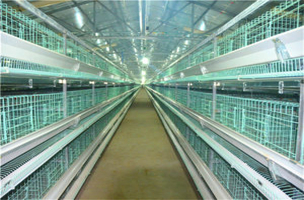How to carry out poultry farming projects in Ghana?
- font size
- Be the first to comment!
With the changes of the times, the intensive chicken raising equipment has become a popular chicken. The traditional chicken houses in the past no longer meet the requirements of modern chicken raising. Therefore, if farmers want to carry out poultry farming projects in Ghana and achieve intensive large-scale chicken raising, they must first plan and rationalize the chicken houses. So how do farmers design and plan chicken farming equipment to raise chicken houses?
1. Sitting direction of the chicken house: Farmers should pay attention to the direction of sunshine and ventilation when designing the chicken house to sit. Closed houses can choose to sit south or southwest to the southeast, with the main windows of the house as far as south or substantially south.
2. Length of the house: The length of the house refers to the length of each house. The length of the house depends on the design capacity and should be determined according to the specific area and span of each house. Large mechanized production of chicken houses is generally 66m, 90m, 120m; small and medium-sized ordinary chicken houses are 36m, 48m, 54m. The length of the house can be determined by the formula: the length of the house, the area of the house, and the span of the house.

3. The span of the house: The span of the house is the width of the house. The choice of the span of the house should be determined according to the size of the equipment to be placed. The cage house should determine the span of the house according to the number of installation columns and the width of the walkway.
4. Height of the chicken house: Nowadays, chickens are kept in cages by raising chicken equipment. The height of the multi-caged cages is related to the cage height and span and climatic conditions, generally 2.5-3m. In dry and hot areas, the height of the house may be suitably higher to facilitate ventilation, and the cold areas may be suitably shorter to facilitate insulation.
5. Ground of the chicken house: The ground in the house of the chicken house is generally 30cm above the ground outside the house, and the area with high humidity or groundwater level should be more than 50cm. The ground of the chicken house requires a firm surface and no gaps. It is mostly flattened with concrete. Although it is expensive, it is easy to clean and disinfect, and it can prevent moisture and keep the house dry. The ground of the cage house should have a shallow ditch, 15-20cm deeper than the ground.
6. The window of the chicken house: Generally, the closed chicken house is provided with a skylight on the upper part of the chicken house, or a floor window is arranged at the lower part of the side wall to adjust the air flow or assist the ventilation. When using mechanical negative pressure ventilation, the fan port is a concentrated exhaust port, and the window is the air inlet, and its area and position should be consistent with the fan power. It is necessary to avoid the formation of the wind and the uniformity of the airflow to prevent turbulence or windless detention areas.
7. Roof of the house: The roofing material requires good thermal insulation to facilitate insulation and insulation. In areas with high temperatures and heavy rainfall, the slope of the roof is larger and the sides of the roof are longer. Roofs in cold areas can be roofed with a layer of rice husks or hay to increase thermal insulation.
These are some of the key points in the poultry farming project in Ghana. The design and planning of the house must be based on the individual needs of the chicken, as well as the needs of the chicken house and the needs of the chicken farm. If the farmers are unable to solve the problem themselves, they can consult the professionals of the poultry equipment supplier who will provide you with a complete poultry house design.


